Ice Skating and Architecture: Warming Huts on the River
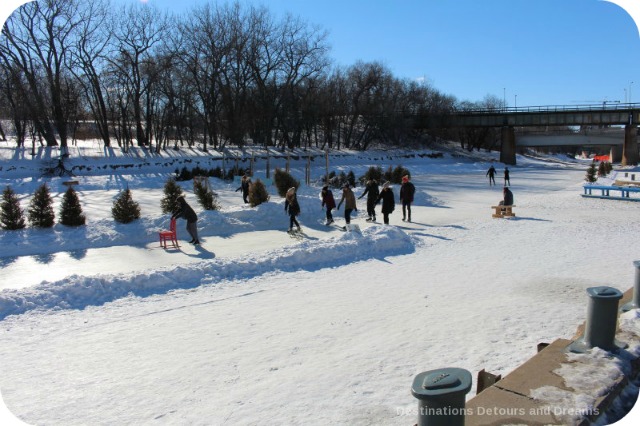
About Winnipeg’s river skating trail and its architectural award-winning warming huts
(Updated February 2022)
Note: This post has been updated to contain current trail information, but I also have a more recent post about the trail. It contains additional information and spotlights more recent warming huts. See Winnipeg’s Nestaweya River Trail: Ice Skating And Artful Architecture. For a look at the interesting architecture of warming huts in 2017 and earlier, continue reading this post.
The Nestaweya River Trail is an outdoor ice skating rink in the heart of Winnipeg, Manitoba. The one time Guinness World Record holder for the longest naturally frozen skating trail in the world is located on the frozen Red and Assiniboine Rivers. Not only does the trail offer kilometres of skating fun, there is a walking trail beside it for those who choose to walk, run, or sled.
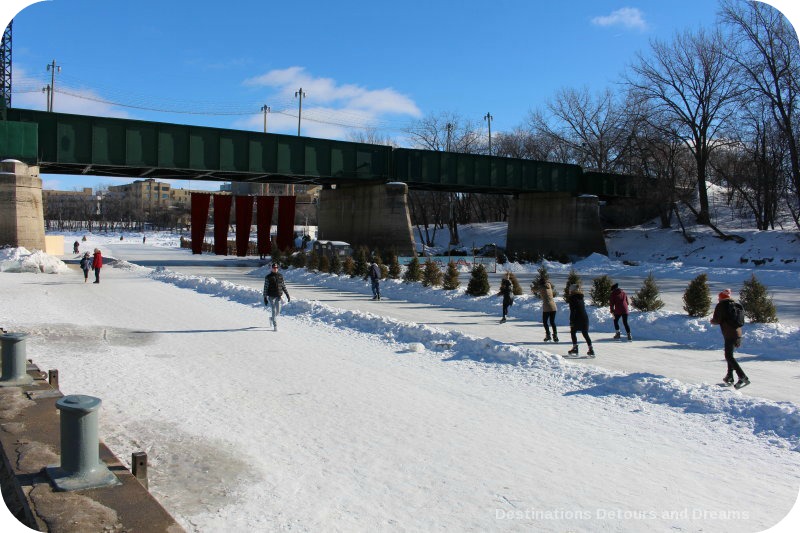
An unique feature of the trail is its warming huts. Since 2009, an annual competition accepts warming hut designs from around the world. A blind jury for Warming Huts: An Art + Architecture Competition selects winning designs which “push the envelop of design, craft and art.” Near the end of January, award winners travel to Winnipeg to begin construction of their designs. The competition continues to garner world attention and attract great architects and artists. Each years sees new designs on the trail along with a smattering of huts from previous years.
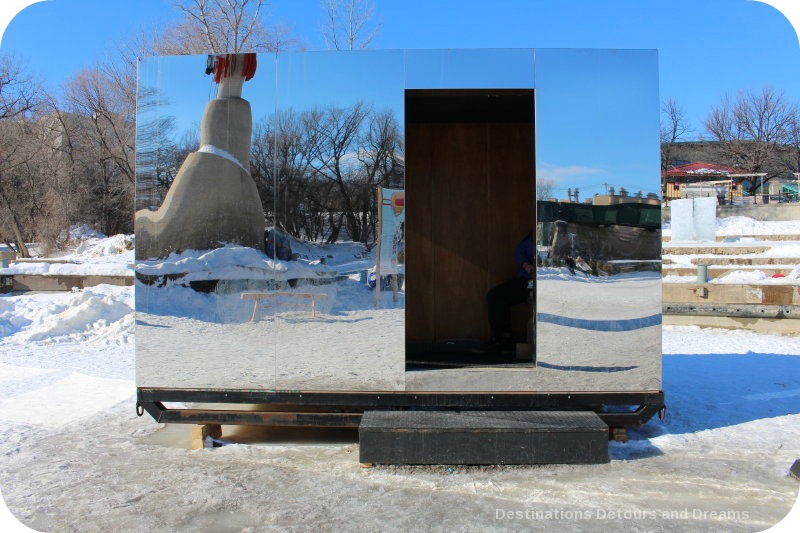
A warming hut created in 2015, “Mirror Cloaking”, sits at the entrance to the trail at The Forks. One-way mirrors and polished stainless steel panels create a mirror box which reflects the landscape around it. The hut makes a good spot to lace up before hitting the trail.
There were over 100 entrants for the 2017 competition. The three winners were: “Ice Lantern” by Lisa Tondino, Alexandra Bolen, Matthew Rodrigues, and Drew Klassen from Nova Scotia, Canada; “Open Border” by Joyce de Grauw and Paul van den Berg from Rotterdam, Netherlands; “Greetings from Bubble Beach” by Team 888 from Chicago, Illinois. In addition to the winners, designs were received from the University of Manitoba Faculty of Architecture and students at Nelson McIntyre Collegiate in Winnipeg. Each year there is also an invited artist. World-renowned British-Indian sculptor Anish Kapoor was the 2017 invited artist.
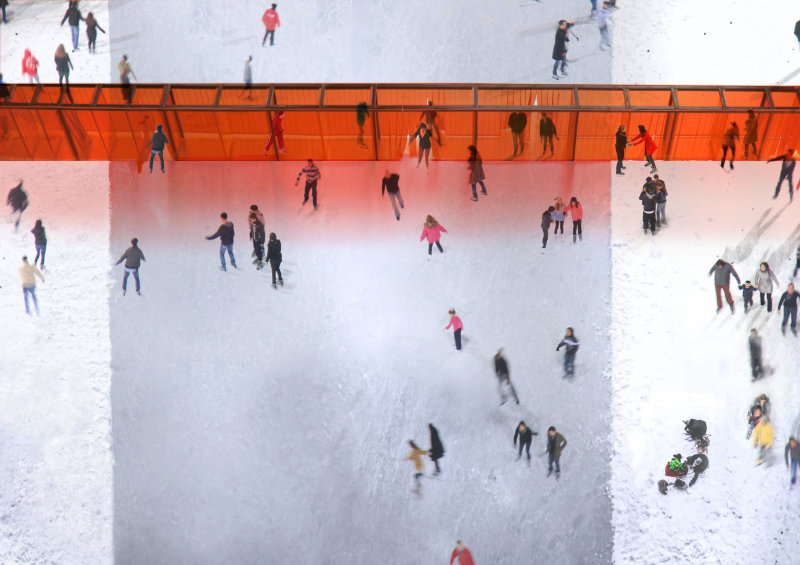
“Open Border” is a straight red wall running perpendicular to the skating trail. The red provides a contrast to the white landscape. The transparent facade is made of insulating and draft-resistant strips. Spaces in the middle of the hut are larger so skaters can pass through, smaller and more intimate at the edges.
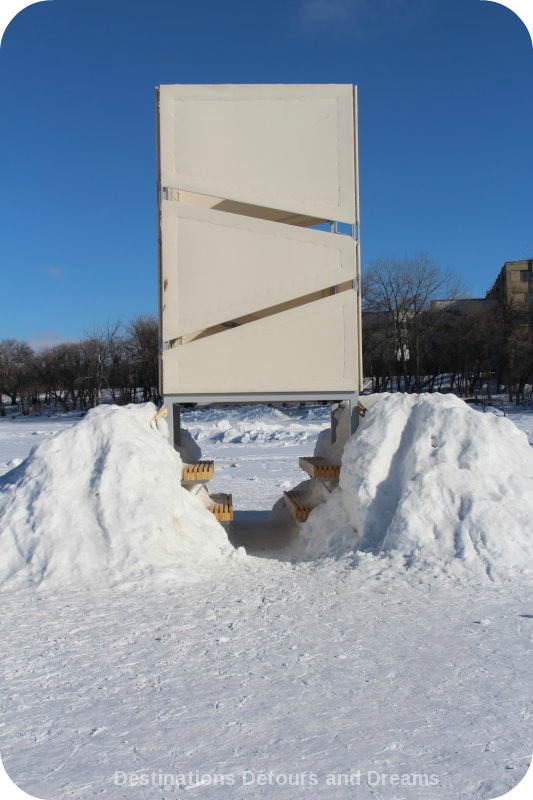
“Ice Lantern” is based on the archetype of the primitive hut. It consists of two main parts: a white lantern hovering above the snow and a snow-mound structure holding the lantern in place. It is a naturally insulated dug-out with wood benches. The hut is open to the sky at top.
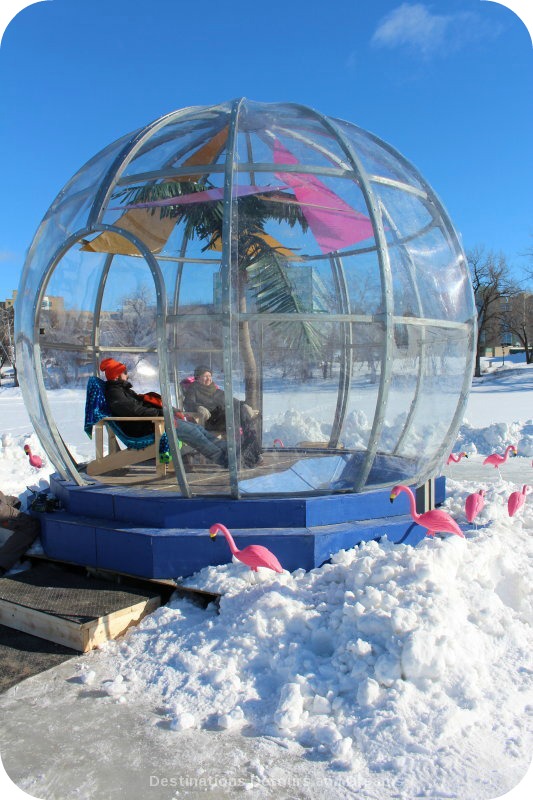
“Greetings from Bubble Beach” is modelled after an inverse snow globe. The transparent geodesic dome creates a bubble of warmth. Deck chairs, a leaning palm tree and pink flamingos create a feeling of summer under the winter sun.
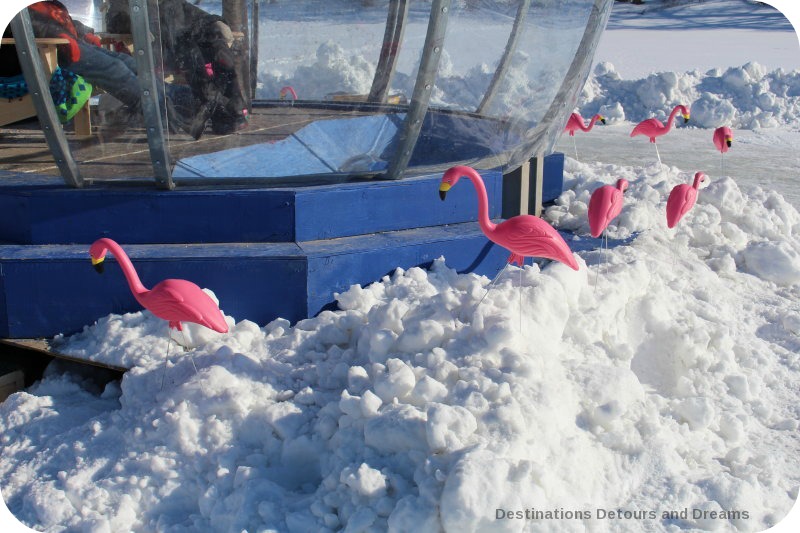
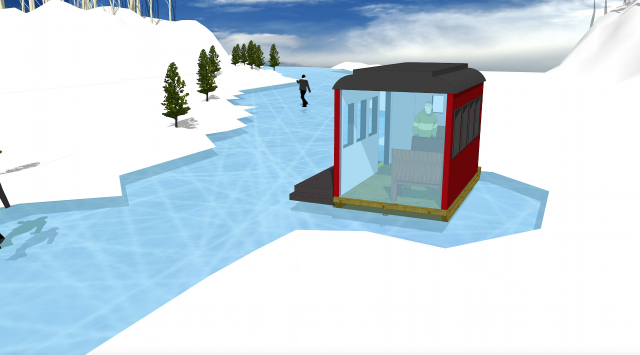
(Photo courtesy of Warming Huts v. 2017)
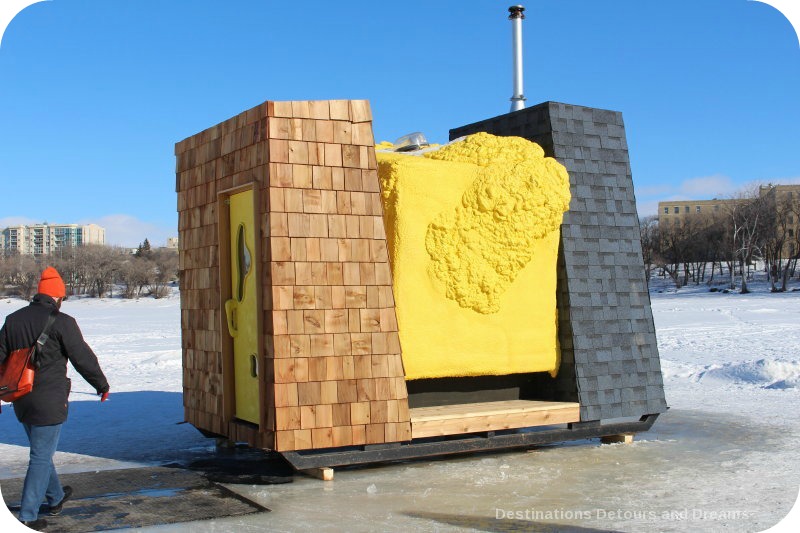
“WARMHUT” is inspired by a sauna structure. The cedar plank-covered hut has a stove inside it which is fueled by pellets made from cattails. It is a hut designed to be truly warm. The stove was not on the day I went inside it, but it was still cozy and warm.
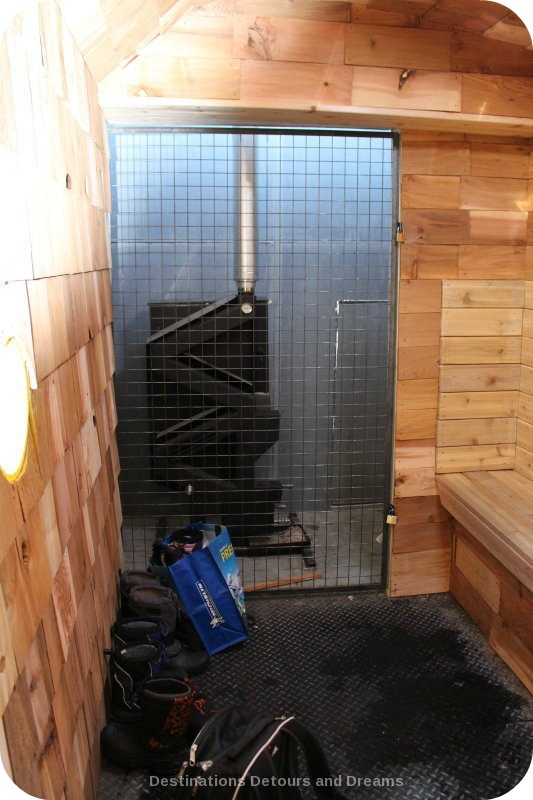
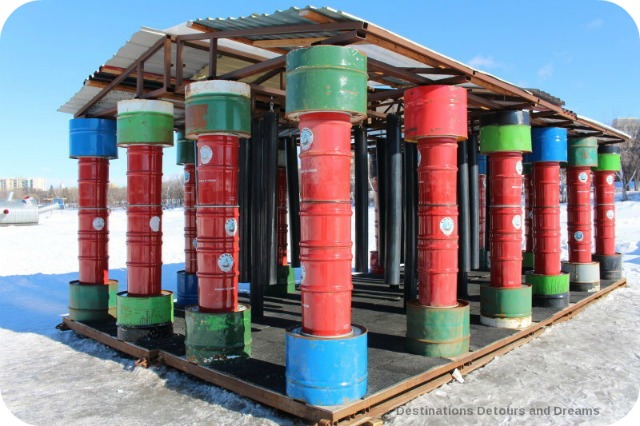
A couple of huts from previous years are also found along the trail. “Temple” by Kirill Blair and Darla Lisitsyna from Russia was a winner in the 2016 competition. It follows the structure of ancient Greek places of worship. The “Hole Idea” by Weiss Architecture and Urbanism Limited from Toronto, Ontario is a 2015 creation.
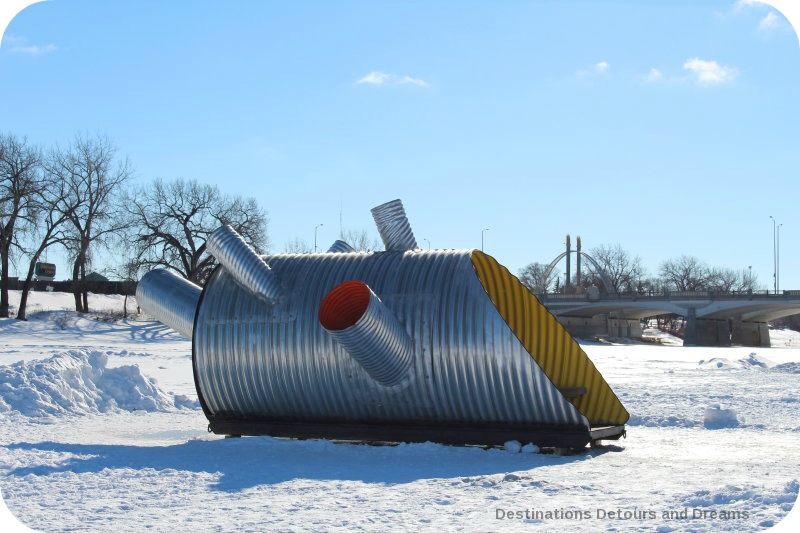
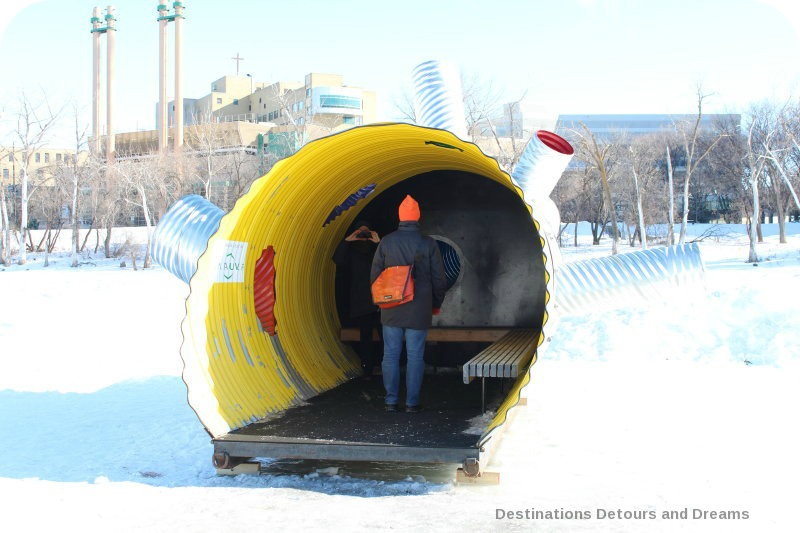
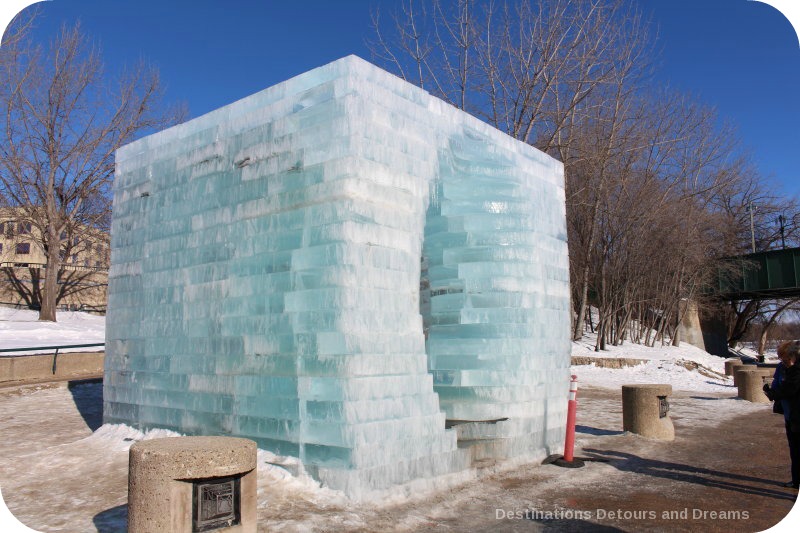
“Stackhouse” by invited artist Anish Kapoor is getting a lot of attention. The 72-tonne structure is made of ice blocks harvested from the Red River. Architect Luca Roncoroni, who created the Victorian apartment at the Sweden IceHotel, led the sculpting team.
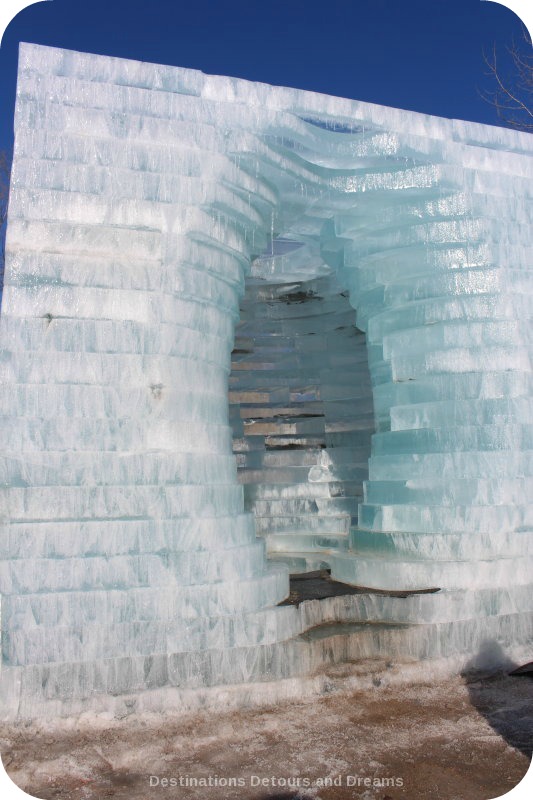
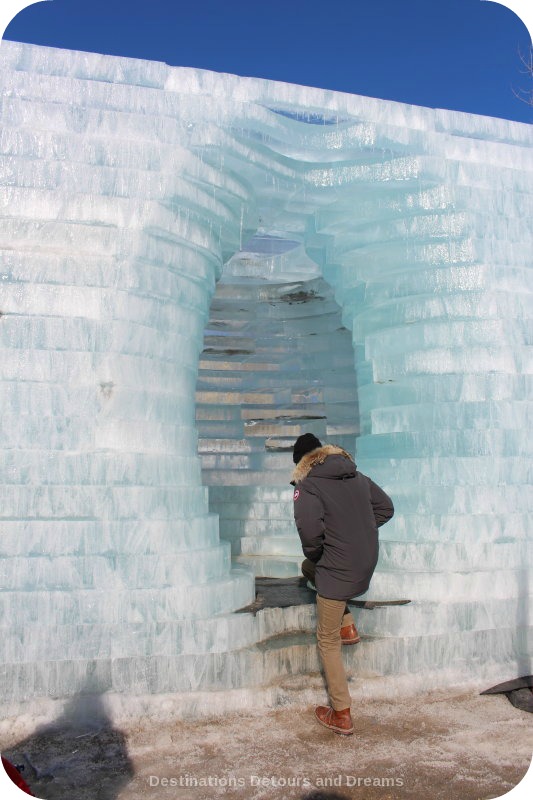
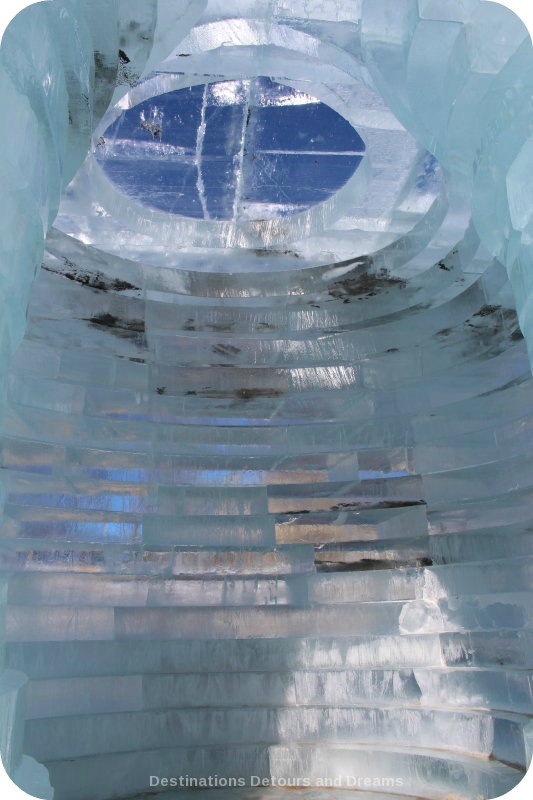
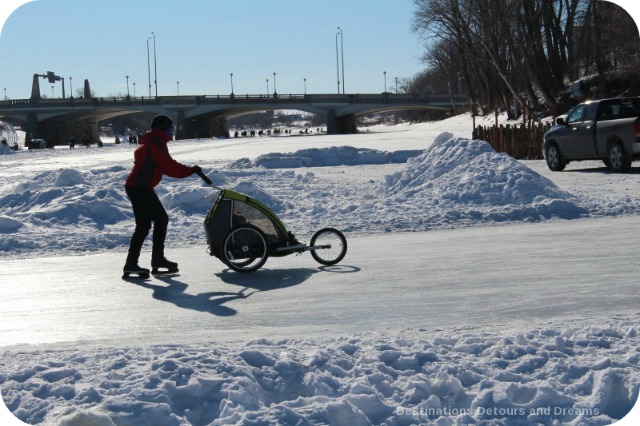
Opening and closing of the trail is dependent on weather. Typically, the trail opens in January and closes sometime in March. The length varies from year to year, again dependent on weather. The trail is accessible from The Forks, is free, and has no set hours. (Note: Nestaweya, the name of the trail, is the original Cree name for the site of The Forks, a long-time meeting point for Indigenous peoples.) The trail is groomed late night or early morning and you need to be aware of machines on the ice at those times. Skates are available for rent at The Forks Market from 10 am to 10 pm weather permitting. If you walk the walking trail, normal winter walking boots are sufficient. Be on the lookout for icy patches, particularly where water may have dripped under bridges.
Information and tips about the trail, along with current conditions and any closures, can be found on its web page. Trail conditions vary with the weather. Check current conditions before you head out.
PIN IT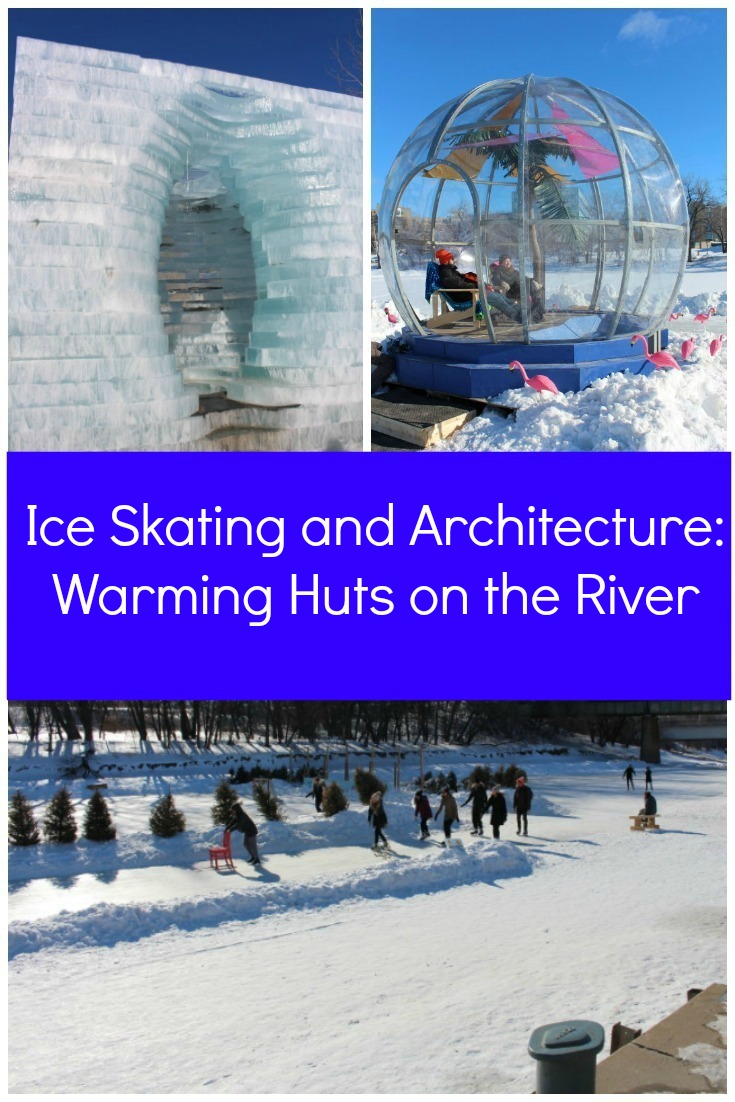
Don’t miss a thing! Destinations Detours and Dreams monthly e-newsletter contains behind the scenes information, sneak peeks ahead, travel story recaps and more. SIGN UP HERE

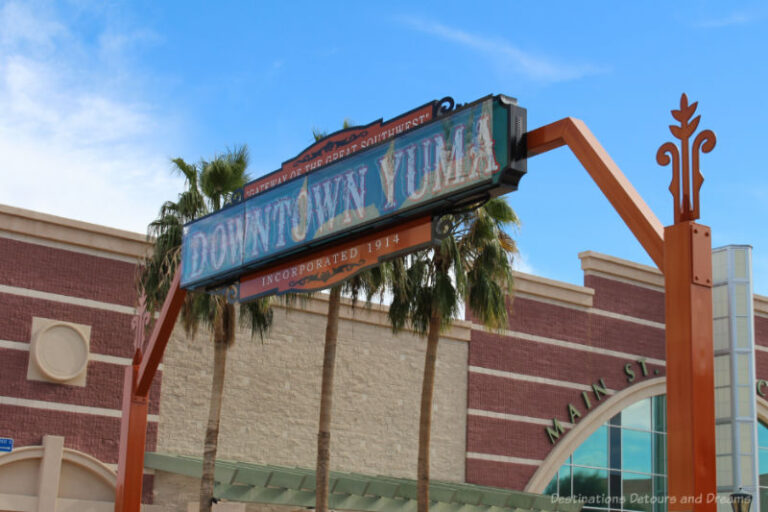
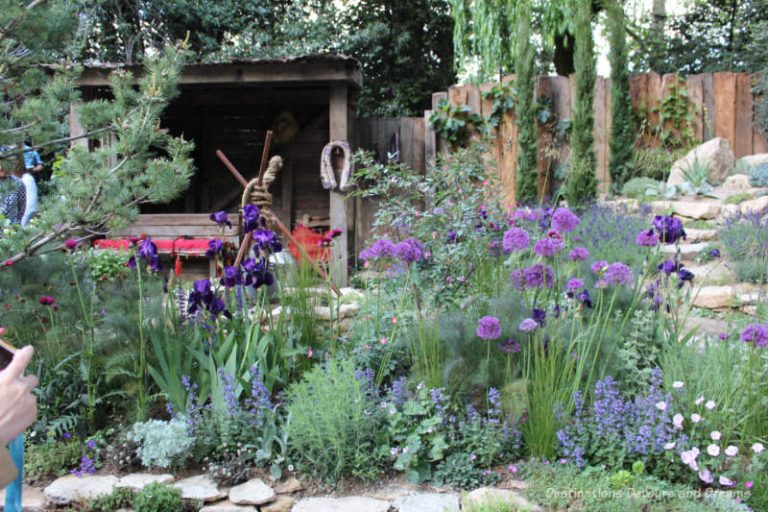
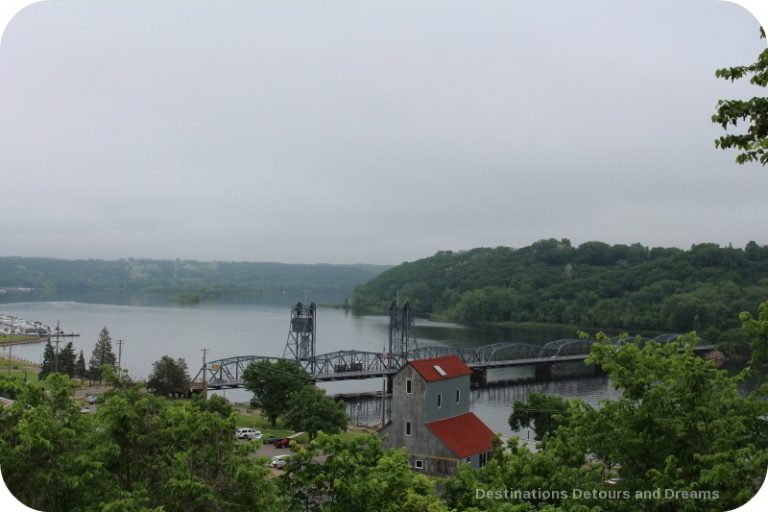
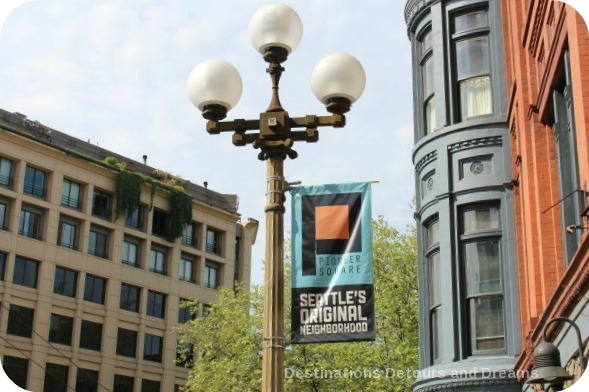
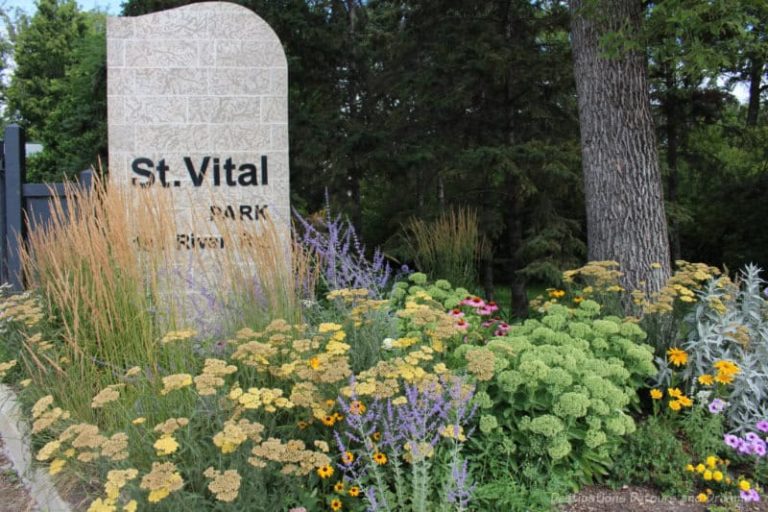
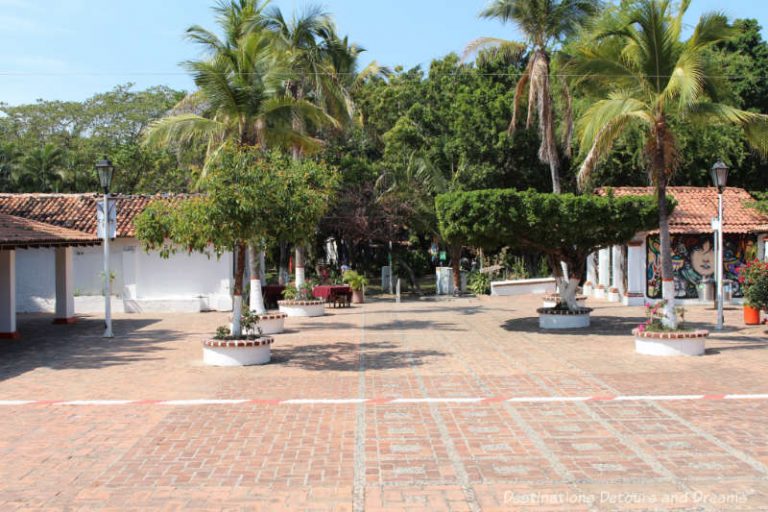
What an interesting trail. The warming huts are really cool. My favorites are the one made of mirrors and the globe. The ice block structure is pretty darn amazing too.
Susan, it is interesting. I’ve loved reading about the huts in previous years, but with being away for the last several winters didn’t get a chance to see them in person. It was great to do that this year.
This is a great post, Donna. Your photos capture what it’s like to skate along the trail admiring the warming huts. It’s bittersweet for me because between travel and the unusually warm weather, I have not been on the ice once this year and it looks like it won’t happen at all now. In past years I have skated the trail once a week. It’s especially enchanting in the evenings when there are not many people and the night sky is above you as you glide along.
Thanks Deb. I haven’t been on the trail at night and I can well imagine it would be enchanting. The weather is supposed to get cooler, so there is a chance the trail will reopen for a short while before the season closes completely. The warming huts have been moved off the river for now and can be seen around the canopy at The Forks.
I’m pretty unsteady on ice skates but that’s looks like enough fun to get me to give it a try.
Ken, or you could walk the walking trail beside the skating trail.
I don’t skate, but I would be up for walking the trail. I love the huts, and fantastic to read that this years winners are from Nova Scotia.
Nancie, walking the trail is fun too.
That’s fantastic! Winnipeg is my home town and I’m thrilled to see how its still thriving and leading the way in the arts. I especially love that Bubble Beach warming hut .
Michele, I liked the Bubble Beach hut too. Winnipeg definitely has an exciting arts scene.
What a unique and beautiful trail. Stack House can be the new igloo! I now know why I should go to Winnipeg!!! When is the best time…when it isn’t that cold but the river is still frozen?
Carol, you ask a tough question. It is too hard to predict exactly when in winter you will get a bitter spell or a mild spell. Typically the trail is open January to sometime in March. The huts may not get placed until late January. You have a better chance of getting milder weather in February than in January. Mid-February is also when Festival du Voyageur is on, so that can be a great time to visit. This year, however, we had so many exceptionally mild days in a row the trail was closed.
What a unique and fun idea! A skating trail? It looks so fun. I love the warming centers.
Sue, the warming huts are certainly a unique feature of this skating trail.
I’ve never been ice skating, but would love to give it try, especially on a skating trail.
Jeri, you could always push a chair for balance like one of the fellows in the top photo.
Those are some very imaginative warming huts, what a great idea and promotion for the architects/artists. Having lived close to the Rideau Canal for half my life I can understand the usefulness of a long ice skating/walking trail for exercise and commute. This is a part of our country I would love to visit some day.
Nathalie, the warming huts certainly attract more people to the trail.
This is great fun, and reminds me of Minneapolis’ Art Shanty project with ice houses built on our frozen lakes. The walk/skating trail is brilliant.
Kristin, I haven’t seen Minneapolis’ Art Shanty project. Another fun idea.
The warming huts look like fun and in those temperatures, very welcome. I just read that Ottawa’s Rideau Canal has the longest naturally frozen ice rink in the world- so Canada rocks when it comes to ice skating.
Billie, I guess we do rock when it comes to ice skating. We need to find ways to get through the cold.
Wow – Love this post Donna. I had a hard time deciding which of the ice huts were my favorites as I thought the message of the “Open Border” hut was timely and the “Stackhouse” had a surreal beauty. However, I think my hands down favorite was the “Greetings from Bubble Beach” which got me laughing. So clever! Anita
Anita, the “Greetings from Bubble Beach” hut can’t help but make you smile or laugh. Delightful bit of whimsy.
I like the variety of the huts–the artists are brilliant. Although it seems it would be cold to me, I think the ice hut is the most striking. I’ll bet the skaters love the length of the skating area. Pittsburgh has a small circular rink in downtown (PPG Place), but it’s not large enough to get up any speed!
RoseMary, I love the artistry of the huts. It is nice to have such a long skating trail.